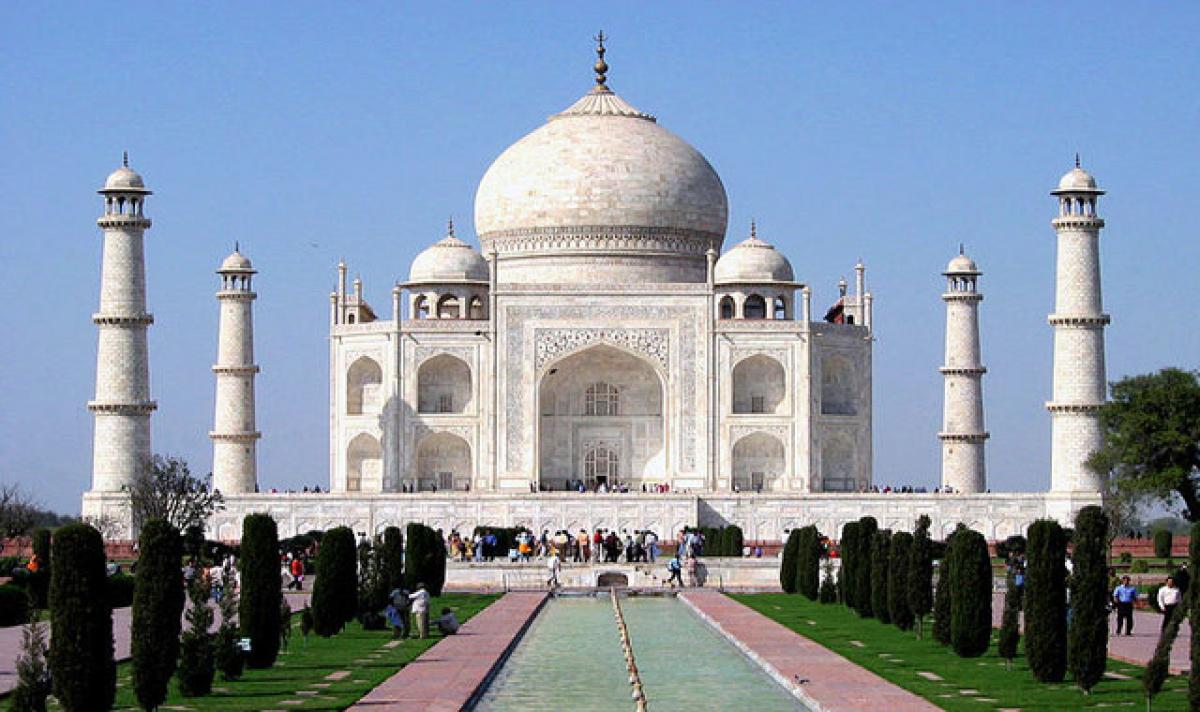Pollution threat to Taj Mahal

It is a known fact that the Taj Mahal, one of the Seven Wonders of the World, was designated as a UNESCO World Heritage Site in 1983.
It is a known fact that the Taj Mahal, one of the Seven Wonders of the World, was designated as a UNESCO World Heritage Site in 1983. It attracts around 3 million visitors a year from all over the world. In the recent past, several alarming cases have come to light threatening the aesthetic beauty of the Taj Mahal.
The Hon’ble Supreme Court and the NGT (National Green Tribunal) heard issues such as tree felling in the eco-sensitive zone near the 17th century mausoleum, on a plot which was about 2.4 km away from monument’s boundary, illegal constructions in and around the white marble mausoleum, construction for residential and commercial purposes in the green belt and agricultural land within 100 meters of the boundary of the monument, etc.
The courts in such cases have directed Government of Uttar Pradesh, Uttar Pradesh Pollution Control Board (UPPCB) and Archaeological Survey of India to submit reports on illegal construction Agra in the Taj Trapezium Zone (TTZ) near the boundary of the Taj Mahal.
In a PIL filed by reputed environmental advocate M C Mehta, the Supreme Court on November 17, 2015 sent a clear warning to Uttar Pradesh government not to allow destruction of the aesthetic beauty of the Taj Mahal by poor quality of constructions around.
The bench of Justice TS Thakur and Justice C Nagappan issued notice to the ASI in petition where Indian Tourism Development Corporation was seeking no-traffic zone around Taj and better tourist management steps.
The bench asked the Archaeological Survey of India (ASI) to respond whether UP government project was in consonance with the aesthetic beauty of Taj. A bench of Justices T S Thakur and C Nagappan questioned the state government for not giving due attention to the finesse of the work and "messing up" the beauty of the Taj Mahal, while perusing pictures of construction of a road on its back side.
The Bench commented: "With chisel and hammer people created this wonder but today with all facilities and scientific knowledge you are not able to match the beauty of medieval time.” The Archaeological Survey of India (ASI), under the Ministry of Culture, is the premier organisation responsible for maintenance and protection of ancient monuments and archaeological sites and remains of national importance.
The ASI Act 2010 imposes a blanket ban on all construction within specified restricted areas (or prohibited zone) of any monument protected by the Archaeological Survey of India and allows limited construction in the next 200 meters (regulated zone).
Regulated area means an area near or adjoining a protected monument which the Central government has, by notification in the official gazette, declared to be a regulated area, for purposed of mining operation or construction of both.
No person other than an archaeological officer shall undertake any construction in a regulated area. No person including the owner or occupier of a protected area shall utilise protected area or any part thereof in any other manner without the permission of the Central government, and whoever contravene it shall be punishable with imprisonment which may extend to three months or with fine which may extend to five thousand rupees or with both, as per Ancient and Historical Monuments and Archaeological Sites and Remains (Declaration of National Importance) Act, 1951 read with by section 126 of the States Reorganization Act, 1956.
A news channel reported, quoting a release by the Archaeological Survey of India in response to an RTI application, that a total of 533 illegal constructions have taken place in the entire Agra circle, out of which 46 have come up in Taj Ganj area.
Many of these unauthorised constructions have taken place at a mere 100 meter distances from the Taj Mahal despite the directive issued by Supreme Court that prohibits any construction within 500 meters of the monument.
Assistant Secretary, Jamat-e-Islami Hind, Intizar Naeem, said: "ASI has only given the information about illegal construction in Agra circle but no information has been given on what steps were taken against the people responsible or to remove the construction.”
Rajkumar Singh, chief of 'Paryatak Ghat Samiti,' an organisation working for preservation of Taj Mahal, said that many agitations have taken place in the past regarding illegal constructions around Taj Mahal but no concrete steps were taken by the ASI and the administration to curb this," said.
(http://www.ndtv.com/agra-news/illegal-constructions-mar-taj-mahals-beauty-507674) There is another risk to Taj Mahar within 500 meters. According to a report of St John’s College, the polluted Yamuna River has been reduced to a swamp with heavy algal growth and deposit of phosphorus (from ash), which form the primary source of food for this species of insect.
The rising pollution level of the Yamuna is now a major threat to the Taj Mahal. Swarms of bugs called Goeldichironomus, which are breeding on its stagnant water, are infesting the marble walls of the monument. The result is greenish black patches on several places on the intricate floral inlay works and ledges of this 17th century marvel.
The Archaeological Survey of India (ASI) is concerned about the bug threat, but its officials said that their purview is limited within the walls of the monument. The insect attack is largely concentrated within a radius of 500 meters, including the back of the Taj (which is the worst affected), and partially on the sides facing the Mosque and that of Mehmaankhaana (royal guest house).
A series of marble panels depicting plant motifs on the walls or reflective tiles used in this part of the monument are getting disfigured by such bug related depositions. Dr Girish Maheshwari, Head of the Department of Entomology at St John’s College in Agra, said the feasible solution lies in the “prevention of eutrophication of the water and the sediments of the river Yamuna near the Taj Mahal”.
Eutrophication refers to slow aging process of a river/water body, resulting in its deterioration to bog or marsh. Highly eutrophic water of the river impacts on the population of small fishes, which are considered predators of the larvae of this insect. There is hardly any fish/aquatic life in the Yamuna today, his report said. This concerned stretch of the river, lies at a stone’s throw distance from the back side of Taj.
(http://www.daily pioneer.com/todays-newspaper/putrid-yamunas-bugs-eating-up-taj-mahal.html) Therefore, safeguarding the cultural heritage would include prohibiting such actions that would adversely affect aesthetic value of such monuments. As the courts have held ASI apart from other civic bodies responsible for maintenance of the Taj Trapezium Zone (TTZ), they cannot escape such accountability in this particular case.
A media report dated March 17, 2017 stated that an association working for protection of Taj Mahal had written a one-page letter to the NGT alleging that illegal construction activity of a hotel and resort in Agra was being undertaken in the Taj Trapezium Zone (TTZ) near the eastern gate of Taj Mahal. It said that one person had allegedly cut 20-25 trees in an area of 12,000 sq feet for building a hotel and when the matter was brought to the notice of the Agra Development Authority, it turned a deaf year to the whole issue.
Uttar Pradesh Pollution Control Board (UPPCB) has told the NGT that construction activity in the Taj Trapezium Zone (TTZ) near the eastern gate of Taj Mahal has been sealed by Agra Development Authority as the representative could not show any permission or licence from any department for construction of the restaurant. This shows that there are illegal constructions around the Taj Mahal and the authorities need to act.
The ASI, as a public authority thus cannot deny their responsibility to report the illegal construction and the officer handling Right to Information (RTI) application cannot 'escape' responsibility of answering queries by simply forwarding the application to other local civic authority.
The ASI Agra is not a post office and the officers there are not dispatch clerks, they are authorities with responsibilities prescribed by ASI Act and also RTI Act. They have to answer the questions of great public interest and their statutory duty without simply passing on the buck to Agra Development Authority. If need be, they have to pursue with local civic bodies to initiate all measures to protect the monument.
CIC imposed fine of Rs 25,000 against two officers of ASI, Agra, for not giving information. (Based on the decision in CIC/SH/A/2016/000795, Bhim Singh Sagar v. PIO, Superintendent, ASI, on 30.5.2017)
By Madabhushi Sridhar














